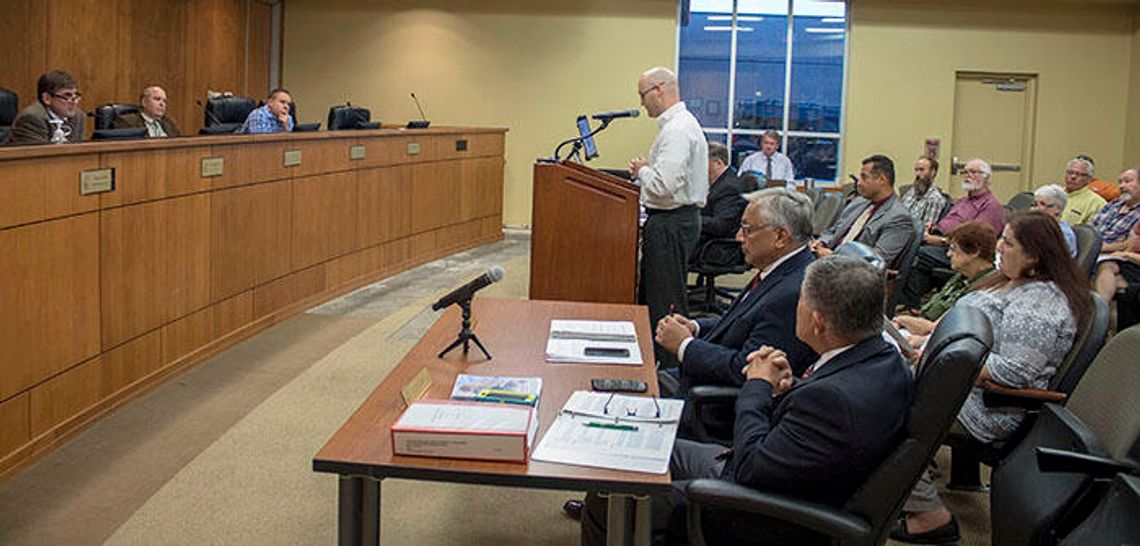“Whoever thought that little stretch of blue dots would cause so much excitement?”
James Earp, Kyle assistant city manager, posed this question when discussing one of five proposed amendments to Kyle’s Transportation Master Plan Oct. 4.
In reality, the little stretch of blue dots represented a massive, and equally controversial, $30 million bridge spanning property over the Blanco River.
The amendment is one of the city’s obligations regarding a development agreement between Nance-Bradshaw Ranches and the City of Kyle.
Other proposed amendments include:
Proposed Amendment 1: Bridge spanning the Blanco River at the end of Cypress Road.
Proposed Amendment 2: A road connecting Lehman Road and Kyle Parkway.
Proposed Amendment 3: A road connecting the south end of Rebel Road (on FM 150) to First Street, that would then connect to the IH-35 access road.
Proposed Amendment 4: A road connecting Kyle Parkway and Beebee Road, parallel to IH-35.
Proposed Amendment 5: A road connecting the south end of Seton Parkway and Philomena Drive.
Under the development agreement, the city will “within 18 months of the agreement’s effective date,” amend the city’s road and transportation plan to include the roads necessary to provide sufficient access to the property when the Project is completely built out.
The project established by the agreement was approved by the Kyle City Council on May 3, 2016 and includes a master-planned development that may include single or multi-family lots, condominiums, commercial or office sites, amenity areas with recreation facilities, public parks and space for civic uses.
Exactly 18 months and one day later, the city upheld its obligation in terms of amending its Master Transportation Plan.
However, there were many concerns from citizens on the issue.
During the council meeting’s citizen comments period, several residents addressed their concerns that not enough information had been provided on the bridge, despite city staff’s claims that the information had been available on the city’s website since May 2016.
The city has addressed these concerns with a press release on its website, as well as providing a link to the May 2016 agreement.
“We’ve actually done quite a bit already,” Earp said. ”In response to public comments, we did put together a statement that addressed most of the concerns.”
“What we did is look at the cost it took to build our bridges across I-35, because we had to have a number to submit to CAMPO ... “It might be $30 million, it might be ten or it might be $500, who knows? What we do know it that we have to start somewhere, and the point was $30 million seemed reasonable.” James Earp, Kyle assistant city manager
One of the miscommunication issues began after back-up information regarding the bridge’s development wasn’t added after the council adjourned its executive session in May 2016.
“We normally do have those attached to the agenda as backup material, in fact the other one that was dealt with that night for the Mccoy family was in the backup material,” said Earp. “The only reason this one wasn’t was that it was so large and there were a couple of last minute changes the attorneys had negotiated and wanted to discuss in executive session.”
Earp also addressed residents’ concerns about the cost of the bridge and where the money for it would come from.
The Blanco-Nance Bridge after the project was placed on the Capital Metropolitan Planning Organization’s (CAMPO) list of potential amendments for its 2040 plan, despite it not being on the city’s transportation plan at the time.
Kyle Mayor Todd Webster said the project was “mistakenly” placed on the CAMPO list for future funding. Several officials with CAMPO’s Transportation Advisory Board, however, preemptively recommended in September not adding the project to the 2040 list due to a lack of information. A formal decision by CAMPO on amendments to the 2040 plan could be made Oct. 16.
“What we did is look at the cost it took to build our bridges across I-35, because we had to have a number to submit to CAMPO,” Earp said. “It might be $30 million, it might be ten or it might be $500, who knows? What we do know it that we have to start somewhere, and the point was $30 million seemed reasonable.”
Earp also stated that the city has never asked for money from taxpayers to fund the project.
“The cost of the bridge falls squarely on the shoulders of the developers,” Earp said. “In their development agreement they asked for city to consider TIF (Tax Incremental Fund) because the bridge is going to cost a lot of money and they know that; all that’s ever been asked was for the city of Kyle to consider creating a TIRZ (Tax Increment Reinvestment Zone) over the eastern part of the property to help pay for their property in the future.”
Earp said CAMPO has development on the east side of the river that they can use to pay into a TIRZ that would then be able to pay for the bridge in the future.
“Unlike other TIRZ such as 1626 where the you incur the debt upfront and hope development comes to pay it back, this was always meant to be put on property on the east side as the development comes and starts to generate the dollars,” Earp said. “All of the east side is going to drive the development of the west side, those dollars could be used to help offset the cost of the bridge.”










